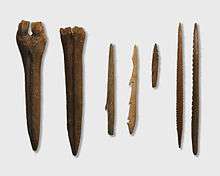Kunda culture
| Geographical range | Europe |
|---|---|
| Period | Mesolithic Europe |
| Dates | c. 8500– c. 5000 BC |
| Type site | Kunda, Estonia |
| Major sites | Pulli settlement |
| Preceded by | Swiderian culture |
| Followed by | Narva culture |
| The Mesolithic |
|---|
| ↑ Upper Paleolithic |
|
| ↓ Neolithic |
Kunda Culture, originating from the Swiderian culture,[1] comprised mesolithic hunter-gatherer communities of the Baltic forest zone extending eastwards through Latvia into northern Russia, dating to the period 8500–5000 BC according to calibrated radiocarbon dating. It is named after the Estonian town of Kunda, about 110 kilometres (70 mi) east of Tallinn along the Gulf of Finland, near where the first extensively studied settlement was discovered on Lammasmäe Hill and in the surrounding peat bog.[2] The oldest known Kunda culture settlement in Estonia is Pulli. The Kunda Culture was succeeded by the Narva culture, who used pottery and showed some traces of food production.
Culture

Most Kunda settlements are located near the edge of the forests beside rivers, lakes, or marshes. Elk were extensively hunted, perhaps helped by trained domestic hunting-dogs. On the coast seal hunting is represented. Pike and other fish were taken from the rivers. There is a rich bone and antler industry, especially in relation to fishing gear. Tools were decorated with simple geometric designs, lacking the complexity of the contemporary Maglemosian Culture communities to the southwest.
Origin of culture
The Kunda culture appears to have undergone a transition from the Palaeolithic Swiderian culture located previously over much of the same range. One such transition settlement, Pasieniai 1C in Lithuania, features stone tools of both Late Swiderian and early Kunda. One shape manufactured in both cultures is the retouched tanged point. The final Swiderian is dated 7800–7600 BC by calibrated radiocarbon dating, which is in the Preboreal period, at the end of which time with no gap the early Kunda begins. Evidently the descendants of the Swiderians were the first to settle Estonia when it became habitable. Other post-Swiderian groups extended as far east as the Ural mountains.[3]
Locations of sites
- Kunda, Estonia
- Pulli, Estonia
- Luga
- Pasieniai, Lithuania
- Ristola, Finland
- Velizh
- Zvejnieki, Latvia
References
- ↑ Niskanen, Markku (2002). "The Origin of the Baltic-Finns" (PDF). The Mankind Quarterly. Archived from the original (PDF) on 2008-10-02. Retrieved 2008-10-06.
- ↑ Shaw, Ian; Jameson, Robert, eds. (1999). A Dictionary of Archaeology. Blackwell Publishing. p. 346. ISBN 0-631-23583-3.
- ↑ Šatavičius, Egidijus (2005). "Swiderian Culture in Lithuania". Lietuvos archeologija. 29. ISSN 0207-8694.